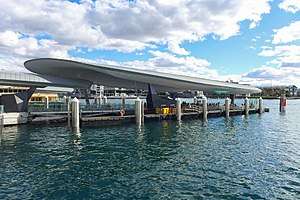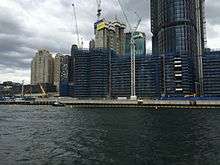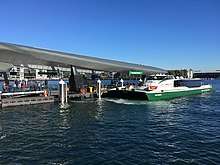Barangaroo ferry wharf
Barangaroo ferry wharf is a ferry wharf located on the eastern side of Darling Harbour, in Sydney, Australia. The wharf is the major public transport link of the Barangaroo precinct, situated west of the Sydney central business district. The complex consists two wharves, with provision for a third wharf in the future. It is serviced by Sydney Ferries' F3 Paramatta River and F4 Cross Harbour services. The wharf opened on 26 June 2017.
Barangaroo | ||||||||||||||||||
|---|---|---|---|---|---|---|---|---|---|---|---|---|---|---|---|---|---|---|
 View of the wharf in August 2017 | ||||||||||||||||||
| Location | Wulugul Walk, Barangaroo New South Wales Australia | |||||||||||||||||
| Coordinates | 33°51′51.297″S 151°12′2.512″E | |||||||||||||||||
| Owned by | Transport for NSW | |||||||||||||||||
| Operated by | Transdev Sydney Ferries | |||||||||||||||||
| Platforms | 2 wharves (4 berths) | |||||||||||||||||
| Connections |
| |||||||||||||||||
| Construction | ||||||||||||||||||
| Disabled access | Yes | |||||||||||||||||
| Other information | ||||||||||||||||||
| Status | Staffed | |||||||||||||||||
| History | ||||||||||||||||||
| Opened | 26 June 2017 | |||||||||||||||||
| ||||||||||||||||||
Barangaroo was built on the premise of being a second major terminal for the Sydney Ferries network, after Circular Quay. The third ferry wharf in the history of the Sydney Ferries network to be situated in Darling Harbour, it serves as a replacement for King Street Wharf 3, designed as a long-term solution to a conclusion made by the Walker Report, which called for easing of congestion through a second terminal at Darling Harbour. Originally scheduled to be opened in 2016, construction of the wharf was delayed by a year, and was controversial for many alleged occupational health and safety violations, which resulted in the death of a worker in February 2017.
History
Background
Ferry services to the Darling Harbour precinct were originally serviced by the Darling Harbour Aquarium wharf. This was the only wharf to service Darling Harbour until Pyrmont Bay was opened in the early 2000s.[nb 1] In 2007, the Walker Report recommended a new ferry terminal at Darling Harbour be built to ease congestion on the network, especially at Circular Quay.[1] The wharf was to be situated at the Darling Harbour wharf, and services to the Aquarium wharf, 250 metres to the east, phased out.[nb 2] Thus Darling Harbour wharf, which was a stop on the Parramatta River service, was chosen as a site for a new terminal. The Aquarium wharf continued to operate as part of Darling Harbour ferry services until 10 October 2010, when as part of a new timetable change all Sydney Ferries services were diverted to Darling Harbour.
The Barangaroo area, which had been a derelict port for years, had been a long-proposed site for urban renewal. Following proposals put forward by the Sydney Harbour Foreshore Authority and reviews by the O'Farrell State Government, major construction and redevelopment at Barangaroo began in 2011.[3] In May 2013, the State Government outlined plans to build a new terminal at Barangaroo to replace Darling Harbour.[4] As well as allowing for additional services on the F3 Paramatta River route, the increased capacity will allow other routes, such as a then-envisioned potential extension of the F7 Eastern Suburbs route, to also use the new wharves.[5] It was proposed that all Sydney Ferries routes that used the Darling Harbour wharf will be rerouted to Barangaroo, with Darling Harbour to be decommissioned and handed back to private operation.[6]
Construction

Construction was originally scheduled to commence in 2015, with the wharves to open in 2016.[7] In April 2015, Transport for NSW issued Invitations to Tender to three companies to build the wharves.[8] A contract was awarded to McConnell Dowell later in September.[9] Over the time period of the wharf's construction, it has been alleged by the Construction, Forestry, Mining and Energy Union that over 1,500 incidents concerning worker safety have occurred on the wharf.[10]
In late February 2017, during the latter stages of the wharf's construction, a worker was killed after being accidentally struck with a metal large header beam while working on a construction barge.[11][12] The man, a Maitland local in his 30s, was reportedly killed instantaneously, and was declared dead at the scene. An investigation into the incident was initiated by SafeWork NSW and the New South Wales Police Force shortly afterward.[13] The accident also sparked attention from local and national media, whom emphasised the "tragic" narrative of the incident; the man being married and fathering a 14-month old son at the time of his death.[10][14] Preliminary investigations found that a metal beam carried by a crane struck a pile of steel beams, causing one to fall off and land on the man's torso, instantly crushing and killing him.[10] The crane's driver was subject to mandatory blood and urine testing afterwards.[10]
New South Wales Minister for Transport Andrew Constance publicly expressed his condolences over the accident, stating that he hoped that the government's agencies would "co-operate fully with all investigations into this very sad incident."[13] The Maritime Union of Australia claimed that the accident was "completely preventable", having been previously denied access to the site when they attempted to investigate reports unsafe work conditions, prior to the fatal accident.[14][15]
Opening
The wharf was completed in late June 2017, estimated to have cost A$59 million to build overall.[16] The first ferry to arrive at the wharf, on the morning 26 June 2017, was the MV Fred Hollows, which had entered service onto the Sydney Ferries network as the first Heritage-class ferry, the same day.[17] The ceremonial first service was attended by Berejiklian and Constance, whom officially opened the wharf upon arrival.[18] The wharf's opening followed the decommissioning of the nearby Darling Harbour / King Street Wharf 3, with the wharf returning to private hands upon its last Sydney Ferries services on the night of 25 June 2017, with Barangaroo serving as its replacement as intended.[16] The wharf initially services the F3 Parramatta River and F4 Darling Harbour routes, both from wharf 1 of the complex, while wharf 2 remains closed. Changes to the F3 and F4 timetables also came into effect on 26 June 2017, to accommodate for the opening of Barangaroo and decommissioning of Darling Harbour.[19] The timetables for the State Transit Authority bus routes 466 and 513, which service the Cabarita and Meadowbank ferry wharves, were also modified in accordance to the new changes.[19]
Design

Both wharves at Barangaroo are measured at 48 meters long and 23 meters wide, with both wharves being able to accommodate a maximum of eight ferries at any given time, with two on each of its four berths.[17] Designed by Aurecon and Cox Architecture, whom had previously helped design the wharves of Brisbane's ferry network,[20] the complex is similar to the design of wharves on Sydney Harbour redeveloped in the 2010s, with large, "curved silver roofs" as the artistic centerpiece of the structure.[6] The complex also features "fully accessible pontoons, seated waiting areas, weather protection, [and] real-time service information", with open, ungated access accompanied by opal card reader nodes at the entrance to both wharves.[6] Lead architect David Holm stated that the wharf's design was crafted with the "language that is consistent with the suite of Sydney harbour ferry wharves" in mind, describing the "twofold" process of resolving function and identity. He further commented that the wharf's function, the "delivery of streamlined passenger flows and a simplicity of functional layout" was contrasted with its identity, an "expression of Sydney harbour’s iconic maritime history and architectural form.[20]
The wharf's location on Barangaroo's Wulugul Walk enables direct access to the Sydney central business district; it also enables a transport interchange link to Wynyard railway station through the Wynyard Walk, an underground pedestrian tunnel purpose-built to allow direct access between the station and Barangaroo.[21][22]
Services

Barangaroo Wharf consists of four platforms on two wharves. Wharf 1's Side A berth hosts ferries operating on the F3 Paramatta River service, while the Side B berth hosts ferries travelling on the F4 Cross Harbour service. Wharf 2 is currently unused as of the June 2017 timetable, and provisions will be made for a potential third wharf in the future.[6][8] Initially, the wharves are expected to be used by up to 11 vessels per hour during weekday peak periods and 14 vessels per hour all day on weekends.[23]
| Platform | Line | Stopping pattern | Notes |
| 1 | Services to Circular Quay Services to Parramatta |
||
|---|---|---|---|
| Services between Watsons Bay and Pyrmont Bay via Circular Quay | |||
| 2 | Currently unused |
Interchanges
Train services from Wynyard station:
- T1 North Shore & Western Line - north to Berowra via Gordon, west to Epping, Emu Plains or Richmond
- T2 Inner West & Leppington Line - to Leppington or Parramatta via Newtown
- T3 Bankstown Line - to Lidcombe or Liverpool via Sydenham
- T2 Airport & South Line - to Macarthur via Kingsgrove and Campbelltown
- T9 Northern Line - north to Gordon, west to Hornsby via Strathfield.
Bus services:[24]
- 311: Millers Point to Railway Square
- 324: Walsh Bay to Watsons Bay via Vaucluse Heights
- 325 Walsh Bay to Watsons Bay via Vaucluse
A future Sydney Metro Barangaroo station will be located nearby.
See also
References
- Notes
- Aquarium Wharf shows up in a colo Ferries map from 1999, and shows up in a 2006 map, dating the opening of the Pyrmont Bay wharf to the early 2000s.
- (Chapter Three, Page 55) "One partial solution to the congestion at Circular Quay is for SFC to develop an additional CBD hub at King Street wharf... SFC currently has exclusive use of King Street No 3 wharf."[2]
- Footnotes
- Besser, Linton; Wainwright, Robert (1 November 2007). "Sydney Ferries' day of reckoning". Sydney Morning Herald. Retrieved 23 March 2015.
- Walker, Bret (1 November 2007). "Report of the Special Commission of Inquiry into Sydney Ferries Corporation" (PDF). Government of New South Wales. Archived from the original (PDF) on 4 March 2016. Retrieved 23 March 2015.
- Foschia, Liz (25 October 2011). "Barangaroo construction officially begins". ABC News Australia. Australian Broadcasting Corporation. Retrieved 23 March 2015.
- ABC News staff (22 May 2013). "NSW Government unveils plans for the future of Sydney ferries". ABC News Australia. Australian Broadcasting Corporation. Retrieved 23 March 2015.
- Saulwick, Jacob (5 May 2014). "Tenders released for Barangaroo ferry wharf". Sydney Morning Herald. Retrieved 23 March 2015.
- O’Rourke, Jim (11 December 2014). "New ferry terminal a part of new Barangaroo skyline preview". The Daily Telegraph. News Corp Australia. Archived from the original on 29 June 2017. Retrieved 23 March 2015.
- Barangaroo Ferry Hub Transport for NSW
- Tender out to deliver Barangaroo Ferry Hub Transport for NSW 24 April 2015
- "Planning approval and contract awarded for Barangaroo Ferry Hub". Transport for NSW. 4 September 2015. Archived from the original on 2 February 2016.
- Harris, Christopher (2 March 2017). "Crushed Barangaroo worker had pregnant partner". The Daily Telegraph. News Corp Australia. Archived from the original on 3 May 2017. Retrieved 3 May 2017.
- Marchese, David (2 March 2017). "Man crushed to death after being struck with metal beam on barge in Barangaroo". ABC News Australia. Australian Broadcasting Corporation. Archived from the original on 3 May 2017. Retrieved 3 May 2017.
- Bleby, Michael (1 March 2017). "Worker killed on construction of Barangaroo Ferry Hub in Darling Harbour". The Australian Financial Review. Fairfax Media. Retrieved 3 May 2017.
- Mitchell, Georgina (1 March 2017). "Man dies in workplace incident at Barangaroo". The Sydney Morning Herald. Fairfax Media. Archived from the original on 3 May 2017. Retrieved 3 May 2017.
- news.com.au staff (3 March 2017). "Barangaroo construction worker Tim Macpherson killed in accident". News.com.au. News Corp Australia. Archived from the original on 3 May 2017. Retrieved 3 May 2017.
- Australian Associated Press (2 March 2017). "Death of NSW rigger was preventable: union". SBS World News. Special Broadcasting Service. Archived from the original on 3 May 2017. Retrieved 3 May 2017.
- O'Sullivan, Matt (26 June 2017). "Sydney's new ferry hub at Barangaroo opens to commuters". The Sydney Morning Herald. Fairfax Media. Archived from the original on 27 June 2017. Retrieved 27 June 2017.
- McPhee, Sarah (26 June 2017). "New Barangaroo Wharf open for ferries". News.com.au. News Corp Australia. Archived from the original on 27 June 2017. Retrieved 27 June 2017.
- Nine News staff (26 June 2017). "New Barangaroo Wharf open for ferries". Nine News. Nine Network (Nine Entertainment Co.). Archived from the original on 29 June 2017. Retrieved 29 June 2017.
- Transport for New South Wales staff (26 June 2017). "Barangaroo Wharf opens with additional ferry services". Transport for New South Wales. Government of New South Wales. Archived from the original on 29 June 2017. Retrieved 29 June 2017.
- Architecture and Design staff (26 June 2017). "Barangaroo gets a globally-inspired ferry hub". Architecture and Design. Archived from the original on 29 June 2017. Retrieved 29 June 2017.
- Australian Associated Press (5 May 2014). "New ferry hub at Sydney's Barangaroo". The Australian. News Corp Australia. Archived from the original on 7 April 2015. Retrieved 23 March 2015.
- O’Rourke, Jim (10 November 2014). "Barangaroo development: Wynyard Walk takes shape in Sydney". The Daily Telegraph. News Corp Australia. Archived from the original on 7 April 2015. Retrieved 23 March 2015.
- "Barangaroo Ferry Hub". Transport for NSW. Retrieved 9 February 2017.
- "New bus services set to roll into Barangaroo and Walsh Bay". Transport for NSW. 17 July 2015. Archived from the original on 20 July 2015. Retrieved 6 September 2015.
External links
| Wikimedia Commons has media related to Barangaroo ferry wharf, Sydney. |
- Barangaroo Wharf at Transport for New South Wales (Archived 11 June 2019)